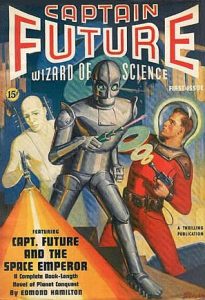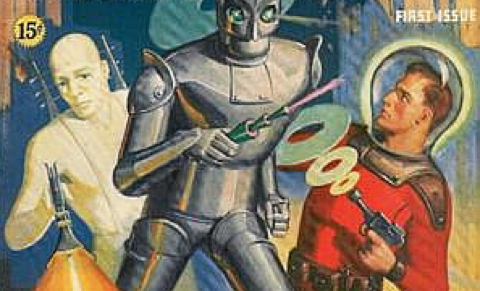 The Wizard of Science
The Wizard of Science
Captain Future is a science fiction pulp hero with a very long reach. He’s appeared in more than two dozen stories, comics, cartoon and live-action television shows, and may yet appear in a big-budget movie. His origin owes much to Doc Savage, and some of his gimmicks were re-tooled for SUPERMAN and BATMAN. He’s even been written about by one of New York’s premier humorists, S. J. Perelman.
Brilliant, red-headed Curt Newton is one of Edmond Hamilton’s most famous characters and yet Hamilton neither created him, nor wrote all the stories. Captain Future has fans all over the world and new adventures are appearing today in books and magazines.
The Birthplace of Creation
The character of Captain Future was created by Leo Margulies and Mort Weisinger allegedly in response to early science fiction fandom at the First World Science Fiction Convention in the summer of 1939. The original idea was for a character called, “Mr. Future: Wizard of Science,” a space-age Doc Savage with three alien side kicks. Mr. Future was a genetic superman who battled evil in the 21st Century. (Ironic, as Weisinger would later edit SUPERMAN.)
Margulies and Weisinger hired Edmond Hamilton to write the series. Hamilton helped refine the characters and storyline and dubbed Future’s sidekicks, “The Futuremen.” These became Grag, a hulking mechanical man of great strength and good-natured loyalty; Otho, a white-skinned, emerald-eyed android of great wit and intelligence; and Simon Wright, an elderly scientist who, at death, had his brain encased in a transparent, life-sustaining box fitted with artificial eyes and mouth. During this early design process “Mr. Future” became “Captain Future.”
Calling Captain Future
After the initial drafts, Curtis Newton was no longer a genetic superman, but remained a brilliant young scientist, superb athlete, and brave, heroic crusader. He’s the son of gifted biologist, Roger Newton, and his wife, Elaine. Both of Curtis’ parents are murdered by Victor Corvo, who tracked them to their hidden sanctuary on the Moon to steal Roger’s secrets for the creation of artificial life.
Thereafter, infant Curtis is raised by Roger’s co-worker, Simon Wright, the brain, Grag, the robot, and Otho, the android. Curtis has a remarkable upbringing. His three unhuman guardians train the boy to unparalleled scientific knowledge, incredible strength and stamina based on a system of super-exercises, and unbelievable swiftness of physical and mental reactions. Curt and Simon Wright develop a super-ship, “The Comet,” and use it to travel around the solar system and visit the various worlds. When he’s grown, Curtis is told the details of his parents’ murders. He then chooses to become Captain Future, “. . . implacable Nemesis of all oppressors and exploiters of the System’s human and planetary races.”
Besides the Futuremen, Curt’s team includes two members of the Planet Police force — Secret Agent Joan Randall and Marshal Ezra Gurney.
The Triumph of Captain Future
The first novel, “Captain Future and the Space Emperor,” debuted in the premiere issue (Winter 1940) of CAPTAIN FUTURE: WIZARD OF SCIENCE. The story was good escapist fun and prompted humorist, S. J. Perelman, to write a NEW YORKER review entitled, “Captain Future, Block That Kick!” which, although tongue-in-cheek, is still a delightful read.
CAPTAIN FUTURE continued for seventeen issues and included novels, short stories and features such as: “The Worlds of Tomorrow,” “The Futuremen,” and “The Future of Captain Future.” It got a name change for the Winter 1941 number and became CAPTAIN FUTURE: MAN OF TOMORROW. The magazine was just hitting its stride when America entered World War II. Edmond Hamilton expected to be drafted and resigned from the series. Margulies hired two pulp writers to replace him — Manly Wade Wellman and Joseph Samachson (pen name of William Morrison). A house name of “Brett Sterling” was attached to the series even before Hamilton stopped writing it. As it turned out, Hamilton wasn’t drafted and continued writing the series under the name of Brett Sterling.
Wartime brought some unusual problems to the magazine. In one case, U. S. Customs seized one of Hamilton’s manuscripts during a border crossing from Mexico. The agents were suspicious of the maps showing an imaginary planet called “Vulcan,” inside the orbit of Mercury. This caused a production delay until Hamilton got his materials back from Washington.
An editorial snafu with an unnamed editor caused Hamilton and Samachson to produce two novels with too-similar plots. This led to Hamilton re-writing “Outlaw World” and its eventual publication several years later in STARTLING STORIES.
Wartime paper shortages were disastrous for the pulps. Magazines implored readers to reserve copies as print runs were reduced. But even subscriptions weren’t enough to keep the presses running for CAPTAIN FUTURE. The Spring 1944 issue was the last and all remaining CAPTAIN FUTURE stories were added to their sister magazine, STARTLING STORIES. The character remained in STARTLING until Captain Future retired in 1946.
But not for long. Captain Future and his team returned to STARTLING STORIES in 1950 for a series of character-driven novelettes which are considered some of the best in the run. “The Return of Captain Future” led the way in January 1950. This was followed by six other stories which highlighted different members of the team — Simon Wright in “The Harpers of Titan” (September 1950), Grag in “Pardon My Iron Nerves” (November 1950), Ezra Gurney in “Moon of the Unforgotten” (January 1951), and “Birthplace of Creation” (May 1951) in which Captain Future, himself, is tested. In that story Curt discovers that even he is not immune to the corruption of power.
The Return of Captain Future
When Captain Future wrapped in May of 1951, readers thought they’d seen the last of Curt Newton and his friends. But it wasn’t the end. Twenty-seven years later, in 1978, Toei Animation of Japan produced a fifty-three episode cartoon (anime) series based on thirteen of the original “Captain Future” stories. The series was very well-received and had a global distribution. It remains popular to this day, but not in the United States where poor English translations and editing discouraged fans.
In 2017, German director Christian Alvart, inspired by the Toei animation series, began work on a big budget, live-action Captain Future film. His plan is to have it produced out of Europe with an international cast. The trailer looks promising and comments from fans are very positive.
Captain Future had succeeded in various media, but there were no new stories until the mid-1990’s when sci-fi writer, Allen Steele, got permission from Hamilton’s estate to pen a few new Captain Future stories. He began with “The Death of Captain Future” (ASIMOV’S SCIENCE FICTION, October 1995), then followed it up with “The Exile of the Evening Star” (ASIMOV’S SCIENCE FICTION, January 1999). Both of these are “satirical homages” to the original material.
“The Death of Captain Future” received both the Hugo and Seiun Awards in 1996 and was also short-listed for a Nebula Award.
in 2018, Steele had a new Captain Future novel ready to go with Tor Books. This time it was a modern reboot called AVENGERS OF THE MOON. The book brings the characters and technology up-to-date and pushes the stories forward in time to the late 23rd/early 24th centuries (as opposed to the early 21st century of the original.)
Allen Steele’s “Captain Future Novel” was part of a planned trilogy. Unfortunately, after a house editorial change Tor cancelled the second and third books. As luck would have it, Steele’s friend Steve Davidson was about to revive AMAZING STORIES as a print magazine and asked Steele for a story. “Captain Future In Love” (AMAZING STORIES Fall & Winter 2018) is the result, serialized in the first two issues.
Star Trail to Glory
When I started researching this article, I thought I was pretty well-versed on the subject. I’m a big fan of Captain Future, have read all the books, and watched quite a few of the anime. I’ve also written about him before. But this time I dug deeper and discovered a lot more to the story. From the hero’s creation to the twists and turns that followed, I was surprised by all that I found.
And then there are Allen Steele’s new stories. I admit that I’m a purist and wasn’t prepared to accept a rebooted CAPTAIN FUTURE universe. But then it occurred to me that Steele is doing the world a favor by adding new stories to the original catalog. His love of the characters might already have inspired a new generation of readers. And those readers, hungry for more, might look back at the original stories and enjoy them, also.
I have no idea what Hamilton, Wellman, and Samachson would think of AVENGERS OF THE MOON or “Captain Future In Love,” and it’s not my place to guess. What I can be sure of is that every writer wants their creations to last. This month, Captain Future turns eighty years old and what writer wouldn’t be happy with that kind of longevity?
Happy Birthday, Curt Newton! Long may “The Comet” fly.
(Dated Winter 1940, the first issue of Standard Magazines CAPTAIN FUTURE featured front cover art by George Rozen. The artist is best remembered for the many covers that he painted for the popular Street & Smith hero pulp, THE SHADOW. Rozen would paint one more CAPTAIN FUTURE cover — dated Fall 1941 — and two covers for Fiction House’s PLANET STORIES. In later years, he created paperback cover paintings for Popular Library and the “Ace Doubles” series.
Sara Light-Waller is a writer, illustrator, and avid pulp fan. Science fiction pulps are her favorites, especially space opera and thought variant stories. She has published two illustrated New Pulp books with more to come. Catch up with her at Lucina Press.
If you’d like to read more about Captain Future and his Futuremen, click here for a list of references that Sara used to prepare for this post.)






